太阳赤纬角https://zhuanlan.zhihu.com/p/630216177
故名思义,就是太阳直射在赤道上的角度,如下图所示: 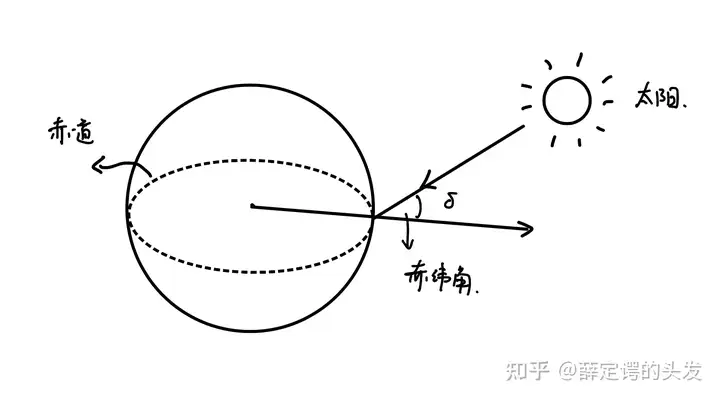
当春分的时候,太阳直射赤道,赤纬角为0度太阳赤纬角的简化计算公式 <span class="MathJax_SVG" id="MathJax-Element-1-Frame" tabindex="0" data-mathml="(1)δ=23.45sin(2π⋅284+n365)" role="presentation" style="display: inline-block; line-height: normal; font-size: 16px; word-spacing: normal; overflow-wrap: normal; text-wrap: nowrap; float: none; direction: ltr; max-width: none; max-height: none; min-width: 0px; min-height: 0px; border: 0px; position: relative;">(1)�=23.45sin(2�⋅284+�365) 式中 <span class="MathJax_SVG" id="MathJax-Element-2-Frame" tabindex="0" data-mathml="n" role="presentation" style="display: inline-block; line-height: normal; font-size: 16px; word-spacing: normal; overflow-wrap: normal; text-wrap: nowrap; float: none; direction: ltr; max-width: none; max-height: none; min-width: 0px; min-height: 0px; border: 0px; position: relative;">� 是计算日期在一年中的日子数,例如 <span class="MathJax_SVG" id="MathJax-Element-3-Frame" tabindex="0" data-mathml="n=1" role="presentation" style="display: inline-block; line-height: normal; font-size: 16px; word-spacing: normal; overflow-wrap: normal; text-wrap: nowrap; float: none; direction: ltr; max-width: none; max-height: none; min-width: 0px; min-height: 0px; border: 0px; position: relative;">�=1 就对应着1月1日 如果你需要更精确的赤纬角计算公式,可以使用由Spencer在1971年提出的公式[1]
<span class="MathJax_SVG" id="MathJax-Element-4-Frame" tabindex="0" data-mathml="(1.1)δ=0.006918−0.399912cos(Γ)+0.070257sin(Γ)−0.006758cos(2Γ)+0.000907sin(2Γ)−0.002697cos(3Γ)+0.00148sin(3Γ)(rad)" role="presentation" style="display: inline-block; line-height: normal; font-size: 16px; text-align: left; word-spacing: normal; overflow-wrap: normal; text-wrap: nowrap; float: none; direction: ltr; max-width: none; max-height: none; min-width: 0px; min-height: 0px; border: 0px; position: relative;">(1.1)�=0.006918−0.399912cos(Γ)+0.070257sin(Γ)−0.006758cos(2Γ)+0.000907sin(2Γ)−0.002697cos(3Γ)+0.00148sin(3Γ)(���)式中 <span class="MathJax_SVG" id="MathJax-Element-6-Frame" tabindex="0" data-mathml="Γ" role="presentation" style="display: inline-block; line-height: normal; font-size: 16px; word-spacing: normal; overflow-wrap: normal; text-wrap: nowrap; float: none; direction: ltr; max-width: none; max-height: none; min-width: 0px; min-height: 0px; border: 0px; position: relative;">Γ 被称作日角,由 <span class="MathJax_SVG" id="MathJax-Element-5-Frame" tabindex="0" data-mathml="n" role="presentation" style="display: inline-block; line-height: normal; font-size: 16px; word-spacing: normal; overflow-wrap: normal; text-wrap: nowrap; float: none; direction: ltr; max-width: none; max-height: none; min-width: 0px; min-height: 0px; border: 0px; position: relative;">� 来确定
<span class="MathJax_SVG" id="MathJax-Element-7-Frame" tabindex="0" data-mathml="(1.2)Γ=2π(n−1)365(rad)" role="presentation" style="display: inline-block; line-height: normal; font-size: 16px; text-align: left; word-spacing: normal; overflow-wrap: normal; text-wrap: nowrap; float: none; direction: ltr; max-width: none; max-height: none; min-width: 0px; min-height: 0px; border: 0px; position: relative;">(1.2)Γ=2�(�−1)365(���) 正午太阳高度角对于纬度为 <span class="MathJax_SVG" id="MathJax-Element-9-Frame" tabindex="0" data-mathml="θ" role="presentation" style="display: inline-block; line-height: normal; font-size: 16px; word-spacing: normal; overflow-wrap: normal; text-wrap: nowrap; float: none; direction: ltr; max-width: none; max-height: none; min-width: 0px; min-height: 0px; border: 0px; position: relative;">� 的地区,正午太阳高度角 <span class="MathJax_SVG" id="MathJax-Element-8-Frame" tabindex="0" data-mathml="hm" role="presentation" style="display: inline-block; line-height: normal; font-size: 16px; word-spacing: normal; overflow-wrap: normal; text-wrap: nowrap; float: none; direction: ltr; max-width: none; max-height: none; min-width: 0px; min-height: 0px; border: 0px; position: relative;">ℎ� 和太阳赤纬角的关系如下图所示 用公式表示: <span class="MathJax_SVG" id="MathJax-Element-10-Frame" tabindex="0" data-mathml="(2)hm=90−(θ−δ)(o)" role="presentation" style="display: inline-block; line-height: normal; font-size: 16px; text-align: left; word-spacing: normal; overflow-wrap: normal; text-wrap: nowrap; float: none; direction: ltr; max-width: none; max-height: none; min-width: 0px; min-height: 0px; border: 0px; position: relative;">(2)ℎ�=90−(�−�)(�)
太阳日照时长计算计算太阳日照时长就是计算昼弧与夜弧的占比,如下图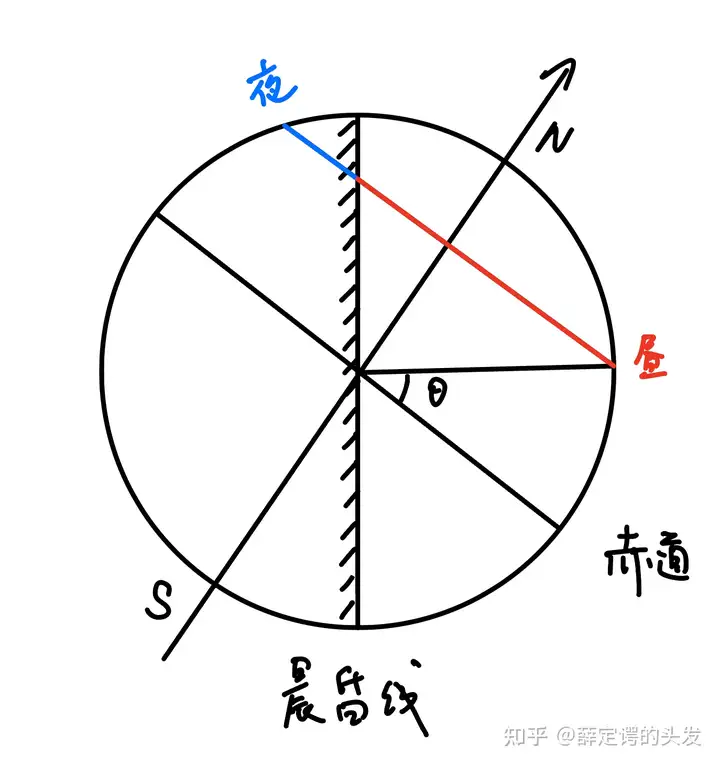 推导过程这里就略去了,直接放结果(感兴趣的同志可以参考Cooper[2]的计算) 对于纬度为 <span class="MathJax_SVG" id="MathJax-Element-11-Frame" tabindex="0" data-mathml="θ" role="presentation" style="display: inline-block; line-height: normal; font-size: 16px; word-spacing: normal; overflow-wrap: normal; text-wrap: nowrap; float: none; direction: ltr; max-width: none; max-height: none; min-width: 0px; min-height: 0px; border: 0px; position: relative;">� 的地区,日照时长为: <span class="MathJax_SVG" id="MathJax-Element-12-Frame" tabindex="0" data-mathml="(3)Ts=215arccos(−tan(δ)⋅tan(θ))" role="presentation" style="display: inline-block; line-height: normal; font-size: 16px; text-align: left; word-spacing: normal; overflow-wrap: normal; text-wrap: nowrap; float: none; direction: ltr; max-width: none; max-height: none; min-width: 0px; min-height: 0px; border: 0px; position: relative;">(3)��=215arccos(−tan(�)⋅tan(�)) 使用这个结果可以用来计算日出和日落的时间,以中国为例:
我国使用的是北京时间(GMT+8),北京市的经度为 <span class="MathJax_SVG" id="MathJax-Element-13-Frame" tabindex="0" data-mathml="116.40o" role="presentation" style="display: inline-block; line-height: normal; font-size: 16px; word-spacing: normal; overflow-wrap: normal; text-wrap: nowrap; float: none; direction: ltr; max-width: none; max-height: none; min-width: 0px; min-height: 0px; border: 0px; position: relative;">116.40�
假定我所在的城市经度为 <span class="MathJax_SVG" id="MathJax-Element-14-Frame" tabindex="0" data-mathml="γ" role="presentation" style="display: inline-block; line-height: normal; font-size: 16px; word-spacing: normal; overflow-wrap: normal; text-wrap: nowrap; float: none; direction: ltr; max-width: none; max-height: none; min-width: 0px; min-height: 0px; border: 0px; position: relative;">� ,我所在的城市太阳达到正午高度角的时间是:
<span class="MathJax_SVG" id="MathJax-Element-16-Frame" tabindex="0" data-mathml="(3.1)Tc=12:00+γ−120360⋅1440(min)" role="presentation" style="display: inline-block; line-height: normal; font-size: 16px; text-align: left; word-spacing: normal; overflow-wrap: normal; text-wrap: nowrap; float: none; direction: ltr; max-width: none; max-height: none; min-width: 0px; min-height: 0px; border: 0px; position: relative;">(3.1)��=12:00+�−120360⋅1440(���)例如天津(经度: <span class="MathJax_SVG" id="MathJax-Element-15-Frame" tabindex="0" data-mathml="117.2o" role="presentation" style="display: inline-block; line-height: normal; font-size: 16px; word-spacing: normal; overflow-wrap: normal; text-wrap: nowrap; float: none; direction: ltr; max-width: none; max-height: none; min-width: 0px; min-height: 0px; border: 0px; position: relative;">117.2� )的达到正午太阳高度角的时间是: <span class="MathJax_SVG" id="MathJax-Element-17-Frame" tabindex="0" data-mathml="12:04" role="presentation" style="display: inline-block; line-height: normal; font-size: 16px; word-spacing: normal; overflow-wrap: normal; text-wrap: nowrap; float: none; direction: ltr; max-width: none; max-height: none; min-width: 0px; min-height: 0px; border: 0px; position: relative;">12:04
那么根据日出到正午和日落到正午的时间相同,可以计算出日出时间和日落时间为:
日出:<span class="MathJax_SVG" id="MathJax-Element-18-Frame" tabindex="0" data-mathml="(3.2)Tup=Tc−Ts2" role="presentation" style="display: inline-block; line-height: normal; font-size: 16px; text-align: left; word-spacing: normal; overflow-wrap: normal; text-wrap: nowrap; float: none; direction: ltr; max-width: none; max-height: none; min-width: 0px; min-height: 0px; border: 0px; position: relative;">(3.2)���=��−��2日落:<span class="MathJax_SVG" id="MathJax-Element-19-Frame" tabindex="0" data-mathml="(3.3)Tdown=Tc+Ts2" role="presentation" style="display: inline-block; line-height: normal; font-size: 16px; text-align: left; word-spacing: normal; overflow-wrap: normal; text-wrap: nowrap; float: none; direction: ltr; max-width: none; max-height: none; min-width: 0px; min-height: 0px; border: 0px; position: relative;">(3.3)�����=��+��2例如天津在2023年5月20日的日出时间为:4:56;日落时间为19:12
(与真实值的误差仅有20秒) 太阳视运动轨迹计算在天球上,太阳的视运行轨迹如下图所示: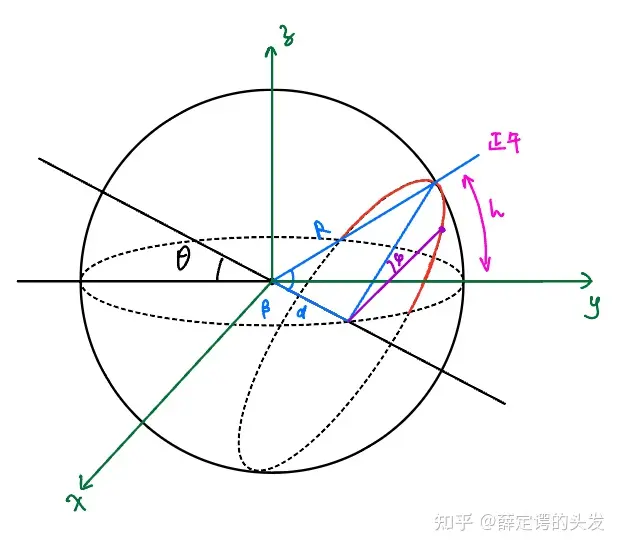 可以看到,对于不同的日期,太阳的运行轨迹发生了平移。根据我们刚刚计算的太阳正午高度角,可以推算出太阳轨迹与日期的函数关系。 Tip:接下来可能会涉及到一些繁琐的数学运算,不感兴趣的同志可以直接跳转到结果部分 日轨部分如红色弧线所示,日轨是在天球上的一个圆环,圆环的圆心 <span class="MathJax_SVG" id="MathJax-Element-20-Frame" tabindex="0" data-mathml="P" role="presentation" style="display: inline-block; line-height: normal; font-size: 16px; word-spacing: normal; overflow-wrap: normal; text-wrap: nowrap; float: none; direction: ltr; max-width: none; max-height: none; min-width: 0px; min-height: 0px; border: 0px; position: relative;">� 的坐标如下: <span class="MathJax_SVG" id="MathJax-Element-22-Frame" tabindex="0" data-mathml="(3)P=(0,dcos(θ),−dsin(θ))" role="presentation" style="display: inline-block; line-height: normal; font-size: 16px; text-align: left; word-spacing: normal; overflow-wrap: normal; text-wrap: nowrap; float: none; direction: ltr; max-width: none; max-height: none; min-width: 0px; min-height: 0px; border: 0px; position: relative;">(3)�=(0,�cos(�),−�sin(�))假定太阳的运行角度为 <span class="MathJax_SVG" id="MathJax-Element-21-Frame" tabindex="0" data-mathml="φ" role="presentation" style="display: inline-block; line-height: normal; font-size: 16px; word-spacing: normal; overflow-wrap: normal; text-wrap: nowrap; float: none; direction: ltr; max-width: none; max-height: none; min-width: 0px; min-height: 0px; border: 0px; position: relative;">� ,太阳相对于日轨中心的位矢为<span class="MathJax_SVG" id="MathJax-Element-23-Frame" tabindex="0" data-mathml="(4)Δr=Rsin(β)sin(φ)ex+Rsin(β)cos(φ)sin(θ)ey+Rsin(β)cos(φ)cos(θ)ez" role="presentation" style="display: inline-block; line-height: normal; font-size: 16px; text-align: left; word-spacing: normal; overflow-wrap: normal; text-wrap: nowrap; float: none; direction: ltr; max-width: none; max-height: none; min-width: 0px; min-height: 0px; border: 0px; position: relative;">(4)Δ�=�sin(�)sin(�)��+�sin(�)cos(�)sin(�)��+�sin(�)cos(�)cos(�)��二者相加,得到太阳的坐标为:<span class="MathJax_SVG" id="MathJax-Element-24-Frame" tabindex="0" data-mathml="(5){x=Rsin(β)sin(φ)y=Rsin(β)cos(φ)sin(θ)+dcos(θ)z=Rsin(β)cos(φ)cos(θ)−dsin(θ)" role="presentation" style="display: inline-block; line-height: normal; font-size: 16px; text-align: left; word-spacing: normal; overflow-wrap: normal; text-wrap: nowrap; float: none; direction: ltr; max-width: none; max-height: none; min-width: 0px; min-height: 0px; border: 0px; position: relative;">(5){�=�sin(�)sin(�)�=�sin(�)cos(�)sin(�)+�cos(�)�=�sin(�)cos(�)cos(�)−�sin(�)根据图中几何关系, <span class="MathJax_SVG" id="MathJax-Element-25-Frame" tabindex="0" data-mathml="β=h+θ=90+δ" role="presentation" style="display: inline-block; line-height: normal; font-size: 16px; word-spacing: normal; overflow-wrap: normal; text-wrap: nowrap; float: none; direction: ltr; max-width: none; max-height: none; min-width: 0px; min-height: 0px; border: 0px; position: relative;">�=ℎ+�=90+� , <span class="MathJax_SVG" id="MathJax-Element-26-Frame" tabindex="0" data-mathml="d=Rcos(β)" role="presentation" style="display: inline-block; line-height: normal; font-size: 16px; word-spacing: normal; overflow-wrap: normal; text-wrap: nowrap; float: none; direction: ltr; max-width: none; max-height: none; min-width: 0px; min-height: 0px; border: 0px; position: relative;">�=�cos(�) 带入后即可得出对应纬度的太阳运动轨迹,编写如下Python程序做一个简单的可视化吧: import numpy as npimport matplotlib.pyplot as pltfrom mpl_toolkits.mplot3d import Axes3D# 定义参数R = 1 # 半径beta = 70theta = 40beta = beta * np.pi / 180theta = theta * np.pi / 180d = R * np.cos(beta) # 计算d的值# 创建φ值phi = np.linspace(0, 2 * np.pi, 100)# 计算x, y, zx = R * np.sin(beta) * np.sin(phi)y = R * np.sin(beta) * np.cos(phi) * np.sin(theta) + d * np.cos(theta)z = R * np.sin(beta) * np.cos(phi) * np.cos(theta) - d * np.sin(theta)# 创建3D图形fig = plt.figure()ax = fig.add_subplot(111, projection='3d')# 绘制原点ax.scatter([0], [0], [0], color="g", label="Origin")# 绘制基础平面circle_x = R * np.cos(phi)circle_y = R * np.sin(phi)ax.plot(circle_x, circle_y, 0, color='lightblue')# 绘制轨迹,颜色根据z的值确定for i in range(len(z)): if z > 0: ax.plot(x[i:i + 2], y[i:i + 2], z[i:i + 2], color='red') else: ax.plot(x[i:i + 2], y[i:i + 2], z[i:i + 2], color='blue')# 显示图例red_patch = plt.plot([], [], marker="o", ms=10, ls="", mec=None, color='red', label="Day")[0]blue_patch = plt.plot([], [], marker="o", ms=10, ls="", mec=None, color='blue', label="Night")[0]plt.legend(handles=[red_patch, blue_patch], loc='upper right')# 显示图形plt.show()

天津,5月20日的太阳轨迹至此,我们就完成了太阳视运动轨迹的计算,有了这个轨迹我们可以很容易的算出太阳的两个方位角。太阳的方位角计算对于在北半球的我们,当太阳达到最大高度角的时候,太阳在我们的南方(也就是 <span class="MathJax_SVG" id="MathJax-Element-27-Frame" tabindex="0" data-mathml="y+" role="presentation" style="display: inline-block; line-height: normal; font-size: 16px; word-spacing: normal; overflow-wrap: normal; text-wrap: nowrap; float: none; direction: ltr; max-width: none; max-height: none; min-width: 0px; min-height: 0px; border: 0px; position: relative;">�+ 方向) 我们将太阳的两个方位角分别记为 <span class="MathJax_SVG" id="MathJax-Element-28-Frame" tabindex="0" data-mathml="(Θ,Φ)" role="presentation" style="display: inline-block; line-height: normal; font-size: 16px; word-spacing: normal; overflow-wrap: normal; text-wrap: nowrap; float: none; direction: ltr; max-width: none; max-height: none; min-width: 0px; min-height: 0px; border: 0px; position: relative;">(Θ,�) ,如下图所示: 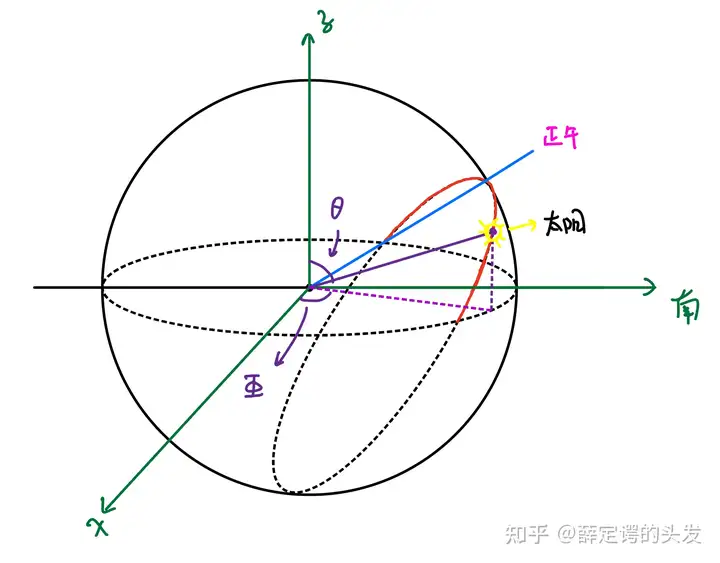 容易有: <span class="MathJax_SVG" id="MathJax-Element-29-Frame" tabindex="0" data-mathml="(6)sin(Θ)=x2+y2R,sin(Φ)=yx2+y2" role="presentation" style="display: inline-block; line-height: normal; font-size: 16px; text-align: left; word-spacing: normal; overflow-wrap: normal; text-wrap: nowrap; float: none; direction: ltr; max-width: none; max-height: none; min-width: 0px; min-height: 0px; border: 0px; position: relative;">(6)sin(Θ)=�2+�2�,sin(�)=��2+�2 北京市5月20日的太阳轨迹回到开头的问题,我们已经成功的参数化表达了太阳的运动轨迹,我们可以回答这个问题了: 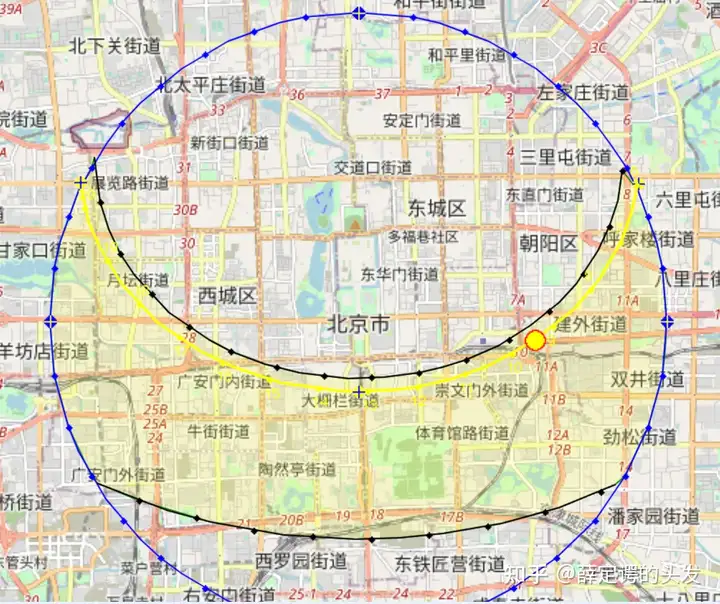
北京,5月20日的太阳轨迹
使用Excel做了一个计算表格: 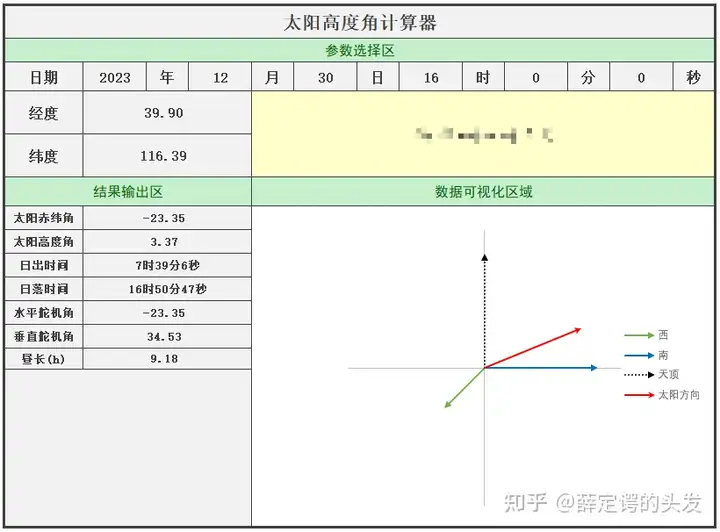
|  分享到朋友圈
分享到朋友圈 分享到朋友圈
分享到朋友圈